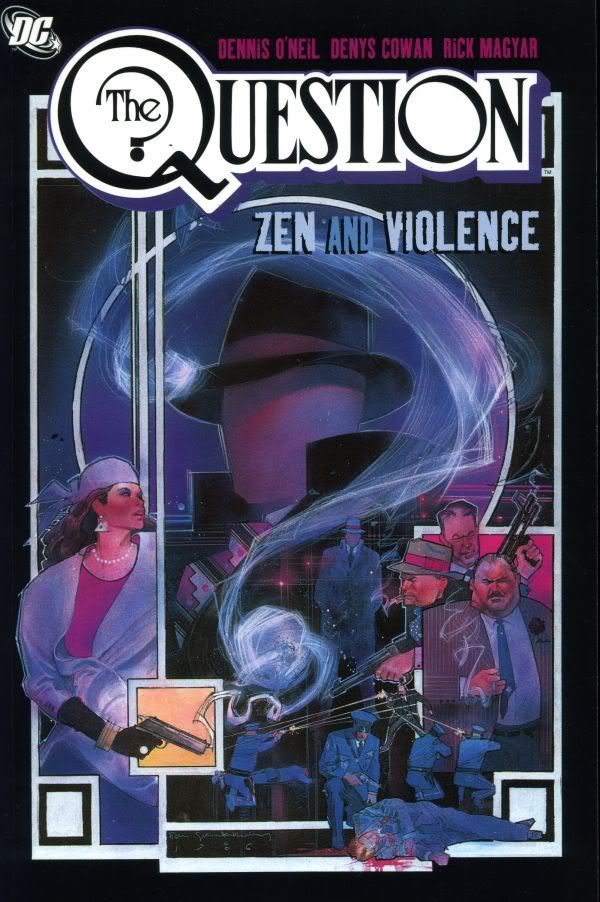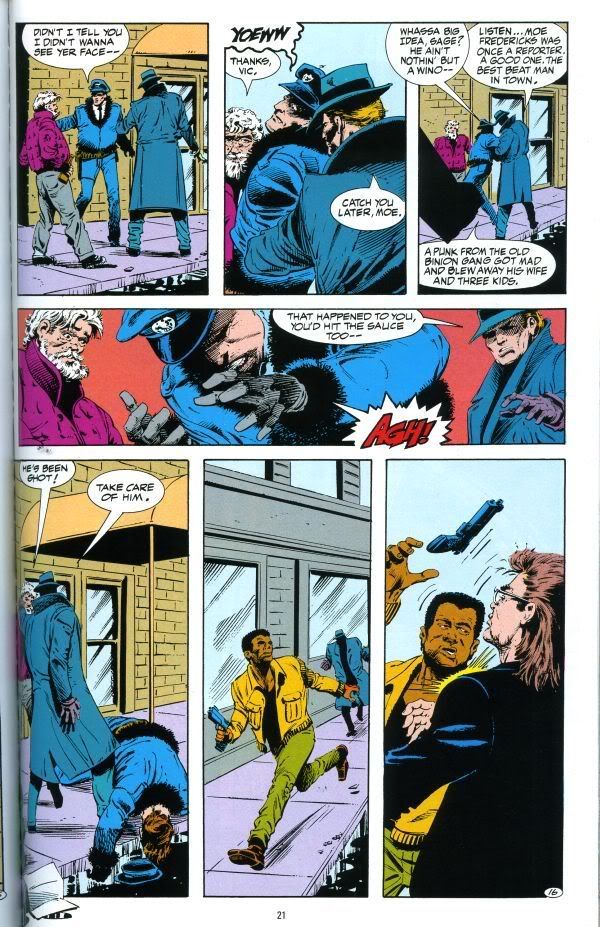The Question: Zen And Violence
This older edition of Long Box Thoughts laid buried deep down in the archives of Geekscape’s features. With the conclusion of Countdown, the Question’s death in 52 and the impending Final Crisis, here it is, on the front page, for all of you to rediscover. -Jonathan
The Denny O’Neil and Denys Cowan era of The Question is one of those titles that is remembered fondly by those who read it, and hardly remembered by those who didn’t. The re-imaging of this Steve Ditko creation was launched in a post-crisis DCU and rode on the wave of the new ‘mature’ hero line that DC was launching in the wake of such success as Green Arrow: Long Bow Hunters, Swamp Thing and Watchmen. The Question series found an audience for its unique take on the action genre and strong use of eastern philosophy. The series lasted for 36 issues, and then became a quarterly title for a little over year before it was officially cancelled. After that, The Question occupied DC Comics limbo, only making an appearance here and there, usually by writers (Rucka, O’Neil) who had a soft spot for the character. The Question, like much of the Charlton Action Heroes ,was at best a c-list character. This list ranking changed though over the course of a little mini-series you may have heard of, called 52.
Over the course of 52, the comic buying world was reintroduced to Vic Sage, just to witnessed his eventual death. As a big O’Neil era fan of The Question, I have mixed feelings about this, which is best to be discussed at a different, and more appropriate time. One positive to come out of this though, was that an interest was generated in the O’Neil/Cowan era, resulting with DC releasing a trade of the first six issues, entitled, Zen and Violence and announcing a second trade to come later this year.
The story arc of this first trade is, like most new titles, focused on introducing the character and the supporting cast. We are introduced to his unattainable love interest, Myra, the loyal friend and confident, Tot, and the corrupt cop who is trying to change, Izzy (who’s story follows an arc similar to another famous DC law enforcer, Harvey Bullock). The series would also reintroduce Richard Dragon and Lady Shiva to the DCU.
 The story starts of with Vic Sage, already having his Question persona, being shown as a brash, cocky man. Quick to anger and quicker to act. Who Vic Sage is, and how he first became The Question is something that would be told slowly over the course of the series. This first arc is not about secret origins and histories as many are, but is instead about rebirth. We see the death of the brash Vic Sage, and witness his rebirth, thanks to Shiva and Dragon, into a more zen like character. Gone is the quick to anger side of Vic, and in its place is a man who believes in the importance of meditation and breathing exercises. Even though, Vic posses a new outlook on life, he is still shown, much like a recoverying addict, to be tempted to lead his life by his old ways, even though he knows he is on the path to be something better. Vic is still flawed. He is a man, like all of us, who is still prone to his old habits. This flaw is what humanizes Victor in ways that the characterization of Batman and other DCU heroes cannot. This questions of identity and of it being possible for someone to truly change their outlook and lifestyle are ones that would reoccur through out the series, and is perhaps its unattended thesis. Each character in the series, including the physical environment of Hub City, in the course of the series are struggling with change, and meeting it with varied success.
The story starts of with Vic Sage, already having his Question persona, being shown as a brash, cocky man. Quick to anger and quicker to act. Who Vic Sage is, and how he first became The Question is something that would be told slowly over the course of the series. This first arc is not about secret origins and histories as many are, but is instead about rebirth. We see the death of the brash Vic Sage, and witness his rebirth, thanks to Shiva and Dragon, into a more zen like character. Gone is the quick to anger side of Vic, and in its place is a man who believes in the importance of meditation and breathing exercises. Even though, Vic posses a new outlook on life, he is still shown, much like a recoverying addict, to be tempted to lead his life by his old ways, even though he knows he is on the path to be something better. Vic is still flawed. He is a man, like all of us, who is still prone to his old habits. This flaw is what humanizes Victor in ways that the characterization of Batman and other DCU heroes cannot. This questions of identity and of it being possible for someone to truly change their outlook and lifestyle are ones that would reoccur through out the series, and is perhaps its unattended thesis. Each character in the series, including the physical environment of Hub City, in the course of the series are struggling with change, and meeting it with varied success.
 As mentioned before, the story has strong elements of philosophy (especially Eastern) in it, and along with a unique creative decision, of not using sound effects, the story at times comes across as being overwritten. There are pages, which are dependent on the dialogue to know what is happening (ex: “The phone is ringing, can you answer it?”), if there was no text, it would be extremely hard at times to follow the story. This is not a problem of the art, but the problem of a creative decision needing to be fleshed out. Having read the series in its entirety, I can tell you this problem lessens as the writing and art come into harmony, but in this trade, the harmony is lacking. See the image to the right for an example of this over writting to work around the lack of sound effects.
As mentioned before, the story has strong elements of philosophy (especially Eastern) in it, and along with a unique creative decision, of not using sound effects, the story at times comes across as being overwritten. There are pages, which are dependent on the dialogue to know what is happening (ex: “The phone is ringing, can you answer it?”), if there was no text, it would be extremely hard at times to follow the story. This is not a problem of the art, but the problem of a creative decision needing to be fleshed out. Having read the series in its entirety, I can tell you this problem lessens as the writing and art come into harmony, but in this trade, the harmony is lacking. See the image to the right for an example of this over writting to work around the lack of sound effects.
Collected here in Zen and Violence, is the initial four issue story arc, and two single issues stories. The single issue stories are by far the gems of this collection, and harken back to the O’Neil and Adams Green Arrow/Green Lantern periods from the 1970’s. These single issues ask compelling questions and paint vivid pictures of the world these characters inhabit. It also the first, and not the last time where we see The Question being a supporting character to Hub City and its elements. These solo stories also benefit from being issue 5 and 6 of the series, as it is clear that the series starting to get its footing.
Overall this trade is not the best introduction to The Question, but it serves to introduce the world that the character inhabits. The trade would have been better served if it contained the first year of issues, or the first annual storyline, Fables (a crossover with the Batman and Green Arrow annuals). Many of the elements in the first four issues build the foundation to the series and will ultimately dictate events throughout the series. If you’re a fan of other O’Neil work, or the Grell era of Green Arrow, the Question is a solid addition to your library. If the use of Mr. Sage in 52 perked your interest in The Question, or are looking for something different and are willing to be challenged in your vigilante super heroics. then The Question may very well be the answer you’re looking for.
